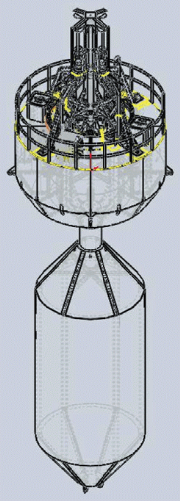
National Instruments LabVIEW, Compact FieldPoint, and CompactRIO have been used in the development of a control and data acquisition system for a wave energy converter (WEC) to achieve efficient power extraction in varying sea conditions
Wavebob, a wave energy technology company based in County Kildare, has been developing a prototype WEC to be deployed in offshore ‘wave farms’, similar to wind farms. The goal is to develop a commercial WEC that can produce significant electrical power for the onshore grid on coastlines with a suitable wave climate.
At full scale, the WEC will have an installed capacity in excess of one megawatt of energy with a 100-unit wave farm providing power for more than 30,000 homes.
Invented by Irish physicist William Dick, the Wavebob WEC is a dual-body point absorber in which the two bodies move relative to ocean waves and to each other. The two bodies are coupled by hydraulic cylinder pumps, which are used to extract power from the relative motion. This part of the WEC is the power takeoff (PTO).
WEC development involves trials at different scales: at small-scale in-wave generating tanks (one one-hundredth to one-tenth) and a larger scale (one-fifth to one-half) with fully operating PTO systems. The development team administers trials with the small-scale WECs in a sink, bath, or pond. When trials are complete and successful, the team builds a full-scale prototype.
To control the PTO in extreme sea conditions while maintaining efficient power extraction, the WEC requires a rugged and sophisticated control system. Each stage of product development also has its own requirements for the data acquisition and supervisory control system, which changes throughout the development cycle.
 Hardware and software
Hardware and software
The WEC prototype trials aim to successfully demonstrate the Wavebob WEC technology and gather data, which would inform the design of a full-scale Wavebob WEC.
A control and data acquisition system for the trials required real-time control of hydraulic valve switching according to sensor input, as well as data acquisition from a variety of sensors at appropriate sample rates. The requirements are similar to those of industrial controller applications, but include unique challenges inherent to operating in varying sea conditions.
These include operating in a marine environment, consequent dynamic effects on equipment, operation from DC source (24 VDC batteries with charging systems), the need for deterministic control (real-time OS), and relatively high-channel-count data acquisition and digital I/O.
The WEC prototypes include a variety of sensors, and the digital I/O includes solenoid switching with significant power requirements. Rapid code development, easy-to-modify control software, code versatility, and standard interfacing are essential.
National Instruments LabVIEW graphical design software proved to be a natural fit for the PTO control system. Its versatility, speed, and simplicity of coding, as well as diagnostic and debugging tools, made it an obvious choice. The range of NI hardware available and its seamless integration with LabVIEW was also beneficial.
LabVIEW coupled with Compact FieldPoint and CompactRIO were selected for the control and data acquisition system to achieve the following benefits: hardware/software integration; rapid development using LabVIEW; Real-time hardware and OS; compact, rugged, and adaptable hardware; upgrade path and distributed system capability; and excellent technical backup.
Control and acquisition system
During the first two trial phases for the Wavebob WEC, the team used Compact FieldPoint with LabVIEW and LabVIEW Real-Time. While the system performed very well, the complexity of the control requirements and channel count increased in the development phase (MK3). The MK3 prototype would require more processor power and faster acquisition rates.
 MK3 prototype
MK3 prototype
The scale of the MK3 WEC prototype, is a quarter of full scale with a fully operable PTO. Given the increasing complexity of control and additional sensors, the team chose CompactRIO hardware, LabVIEW, LabVIEW Real-Time, and the LabVIEW FPGA Module. They also constructed a one-seventeenth scale model for rapid trials of structural and other changes. A new control and acquisition system was built into this model.
CompactRIO was selected for its integration with LabVIEW as well as its processing power and acquisition rates. The hardware offers the ability to run control and data acquisition loops at much faster sample rates without compromising the timing integrity of the system due to processor overload. All control and I/O functions can be programmed on the field-programmable gate array (FPGA) in the CompactRIO backplane and can run simultaneously. The controller only has to read the resulting data when logging. The small footprint and low power consumption of the CompactRIO system also facilitated incorporation into the one-seventeenth scale model.


